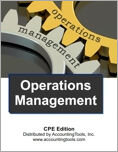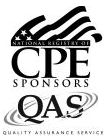Operations Management (CPE Course)
CPE Credit: 18 hours
Course Type: Downloaded PDF materials with online test
Price (with PDF Textbook): $125
Course Description
In most organizations, the bulk of all profits come from the operations functions of the business. Consequently, it makes sense for management to concentrate its efforts on the management of operations. In the Operations Management course, we provide insights into how profits can be improved by examining such topics as performance objectives, operations strategy, product and service innovation, process design, facility layouts, capacity management, and much more.
Author: Steven Bragg
Course Number: PR1004
Table of Contents
Chapter 1. Introduction to Operations Management
Chapter 2. Operations Performance
Chapter 3. Operations Strategy
Chapter 4. Product and Service Innovation
Chapter 5. Operational Structure
Chapter 6. Process Design
Chapter 7. Facility Layouts
Chapter 8. Process Technology
Chapter 9. Personnel in Operations
Chapter 10. Planning and Control
Chapter 11. Capacity Management
Chapter 12. Constraint Management
Chapter 13. Supply Chain Management
Chapter 14. Inventory Management
Chapter 15. Operations Improvement
Chapter 16. Quality Management
Chapter 17. Risk Management
Chapter 18. Project Management
Learning Objectives
Identify the functions associated with operations management.
Recognize the components of a process hierarchy.
Cite the management areas for which an operations manager is responsible.
Recognize the requirements of the corporate social responsibility concept.
Specify the circumstances under which operations flexibility is needed, and how such flexibility is measured.
State the long-term purpose of the operations function.
Identify the various stages of the product life cycle.
Specify the reasons for the operations strategy matrix
Identify the different types of operations strategies.
State the reasons for using strategic experiments in the operations area.
Specify the advantages and disadvantages of the open and closed innovation systems.
Cite the problems with generating a large number of product innovations.
Identify the underlying concept behind the use of innovation measurements.
Recognize the characteristics of a supply network.
Cite the circumstances under which disintermediation makes sense in a supply network.
Recognize the participants in a business ecosystem.
Cite the circumstances when economies and diseconomies of scale occur.
Specify the formula for the breakeven point.
Recognize the circumstances under which forward and backward integration make sense.
Identify the different process types found within a company’s operations.
Specify the most useful process tracking measurements.
Cite the types of information that can be collected by a value stream mapping project.
Specify the advantages of and issues with process standardization.
Recognize the different types of layouts that can be used in an operations facility.
Specify the layout considerations that can have an impact on employees.
Recognize the reasons for using traffic analysis and cluster analysis in operations.
Identify the key performance objectives of a business.
Cite the types of processes most helped by process technology.
Identify the boundaries of the window within which operations technology should be acquired.
Recognize the approaches that can be used to increase the odds of completing a process technology implementation.
Specify the root causes of company culture.
Identify the general classifications of organizational structure.
Recognize examples of the line and staff functions.
Specify the structure of a properly constructed job analysis.
Cite the characteristics of an ergonomically-designed workplace.
Recognize the actions that may be taken to motivate employees.
Identify the performance requirements of a system of planning and control.
Identify when sales and operations planning should be used.
Recognize the different types of demand.
Specify the different types of loading that can be applied to a work center.
Identify the different types of forecasting methods, their characteristics, and when they should be used.
Recognize when a smoothing constant should be used in a forecasting model.
Specify the types of capacity planning methods that can be applied to operations.
Cite the components of a throughput calculation.
Recognize the situations in which local optimization is occurring.
Identify the areas in which an expedite zone can be useful to a business.
Specify the decision criteria for reviewing investment proposals.
Cite the activities included in a supplier assessment.
Specify the issues to consider when choosing a foreign supplier.
Recognize the management alternatives when dealing with a large number of suppliers.
State the advantages of using a stable production schedule.
Identify the options when there is a risk of late deliveries.
Recognize the different types of inventory.
Specify the components of an inventory reordering calculation.
State the different operations strategies and the situations to which they apply.
Identify the key components of a material requirements planning system.
Recognize the activities needed to gain a long-term competitive advantage.
Cite the uses to which the kaizen technique can be put.
Identify the outcome of a successful Six Sigma project.
Specify the headings typically used on a cause-and-effect diagram.
Recognize the characteristics of quality in a product.
Specify the different types of costs associated with quality.
Cite the situations in which a business is better able to retain risk.
Identify the contents of a corporate risk profile.
Specify the tools used to contact employees during an emergency, as well as their advantages and disadvantages.
Identify the planning structure of a project, and what is done during each phase.
Cite the activities included in a planning and control system.
Specify the contents of a work breakdown structure.
Recognize the structure of a Gantt chart.
Recognize the concept of slack time in the management of a project’s critical path.
Level: Overview
Instructional Method: QAS Self-Study
NASBA Category: Production
Prerequisites: None
Advance Preparation: None
Latest Review Date: March 2025
Program Registration Requirements: Click on "Purchase Course" near the top of this page to pay for and access the course. You will then be able to download the course as a PDF file, then take an on-line examination, and then download a certificate of completion if you pass the examination.
Program Refund Policy: For more information regarding administrative policies concerning complaints, refunds, and other matters, see our policies page.
AccountingTools, Inc. is registered with the National Association of State Boards of Accountancy (NASBA) as a sponsor of continuing professional education on the National Registry of CPE Sponsors. State boards of accountancy have the final authority on the acceptance of individual courses for CPE credit. Complaints regarding registered sponsors may be submitted to the National Registry of CPE Sponsors through its website: www.nasbaregistry.org.
The NASBA sponsor identification number for Accountingtools, Inc. is 115881.
AccountingTools is an IRS Approved Continuing Education Provider. We are compliant with the requirements for continuing education providers (as described in sections 10.6 and 10.9 of the Department of Treasury’s Circular No. 230 and in other IRS guidance, forms, and instructions). Our IRS Approved Continuing Education Provider number is 72821.


